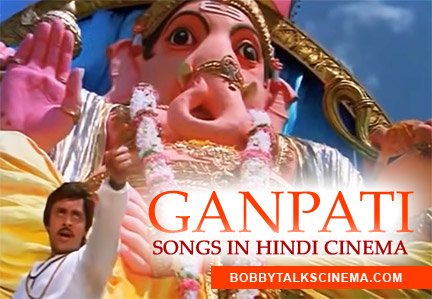
Ganesh Chaturthi is one of the most spiritedly celebrated festivals in India, particularly in Mumbai, Maharashtra, where the entire city slows down for Lord Ganesha. Worshipped as Vighnaharta - the destroyer of all the obstacles, the ten-day festival is celebrated with music and dance, ending with ‘The Visarjan’ (immersion) when the devotees come out together with their idols resulting in a magnificent sight.
While the festival has its mythological, historical and political linkage deserving a detailed study, it also has a cinematic history with the visuals of Visarjan being an integral part of Hindi cinema since the 1980s. Interestingly, it got represented through soothing bhajans in the initial decades of mythological films and one of the earliest references was seen in the 1969 film Pujarin with the lyrics as Ganesh Ji Meri Binti Suniyo Re. The song was visualised as a traditional, comforting bhajan with devotees singing the praises in front of the Ganpati idol along with a woman getting miraculously healed by the prayers.
The Visarjan procession with brass bands, drums, and people dancing on the roads in their traditional attires including Bhangra by Sikhs, was probably presented for the first time in Takkar (1980) in its song Murti Ganesh Ki. The presentation also laid the foundation for the narrative, representing two rival groups in the processions resulting in violence.
The very next year we had one of the most famous songs to date, Deva O Deva Ganpati Deva Tumse Badhkar Kaun in Hum Se Badhkar Kaun (1981) that was again picturised with the key characters dancing in front of their idols competing with each other.
The year 1982 had the most emotionally written song in Dard Ka Rishta in which the young girl lying on the hospital bed remembers the day of Ganpati Visarjan and the song begins as Mere man mandir mein tum bhagwan rahey, mere dukh se tum kaise anjaan rahey. It again had the documented visuals of roads full of people celebrating the occasion.
A few years later, in 1986, a milestone film in Hindi cinema talking about unemployed youth right away began with the real-life footage of Ganpati Visarjan celebrations in its titles. The very first scene of the film was about a violent mishap between two groups of youngsters fighting for their Ganpati to reach the beach first. The fight stops as the police officials come in and the sequence sets the required tense tone for the film. This was N. Chandra’s Ankush, that in reality laid the path for all the gang-war movies.
A similar sequence showcasing the local goons deliberately asking for donations for the festival was again seen in Kaalchakra, the surprise hit of 1988, before the song Jisne Tera Naam Liya.
It was during these years that the on-screen depiction of Ganesh Chaturthi celebrations somehow got associated with action, gang-wars, and crime, moving away from the common-man. While a few films presented it as a cultural song as seen in Aasoo Baney Angarey (1993) and Zordaar (1996), the majority had their focus on the clashes and destruction like Marte Dum Tak (1987), Ilaaka (1989), and more.
Adding to the scenario, the 1990s witnessed some cult films with their climax devised around the festival being celebrated in pandals, temples or the beach and roads among thousands. Apart from the dud Mahaanta (1997), the three trendsetting films of Hindi cinema having similar sequences in their climax were Mukul S. Anand’s Agnipath (1990), Ram Gopal Varma’s Satya (1998), and in a pre-climax form in Mahesh Manjrekar’s Vaastav (1999).
However, as the genre of gangster movies started dying, the new millennium had films again representing the occasion with pulsating music, dance, and splendour, other than the remake of Agneepath (2012) and Sarkar 3 (2017) continuing with the same format. While Viruddh (2005) presented it in a simple, traditional style, the others created ‘a special attraction number’ out of the festival as witnessed in films like Don (2006), My Friend Ganesha (2007), Wanted (2009), ABCD (2013), ABCD 2 (2015), Bajirao Mastani (2015), Banjo (2016) and Judwaa 2 (2017). As a considerable fact, the song in Judwaa 2 even had questionable lyrics expressing it too casually.
Coming to recent years, private renditions praising Lord Ganesha were released during the festival by many renowned artists including Amitabh Bachchan, Ritesh Deshmukh, Shreya Ghoshal, and more. But the most recent addition comes from Salman Khan, who introduces his fresh look as a Sikh police officer in the upcoming
Antim: The Final Truth with the Ganpati track Vighnaharta also featuring Aayush Sharma and Varun Dhawan dancing on the beats.
Hence, the Hindi cinema’s association with Ganpati continues and is here to stay forever.
Bobby Sing
(bobbytalkscinema.com)
NOTE : The article was first published as my Sunday column in THE FREE PRESS JOURNAL Newspaper (Mumbai Edition) on 12th September 2021.
Note : The write-up is a chapter shared from my upcoming book releasing soon. So any additions, rectifications suggested by friends are welcome to make it better.
----------
 For more such interesting articles on lesser known facts on Hindi Cinema, do try DID YOU KNOW
For more such interesting articles on lesser known facts on Hindi Cinema, do try DID YOU KNOW Series by
Bobby Sing available in both
Book and
E-book form
.
Also available
at Notionpress and Flipkart stores (in India)


 For more such interesting articles on lesser known facts on Hindi Cinema, do try DID YOU KNOW Series by Bobby Sing available in both Book and E-book form.
For more such interesting articles on lesser known facts on Hindi Cinema, do try DID YOU KNOW Series by Bobby Sing available in both Book and E-book form.